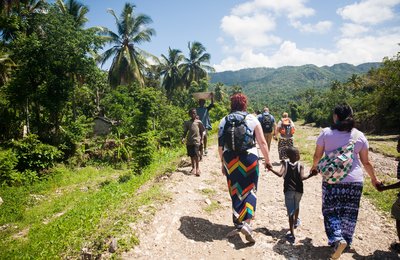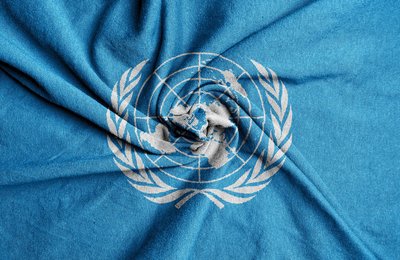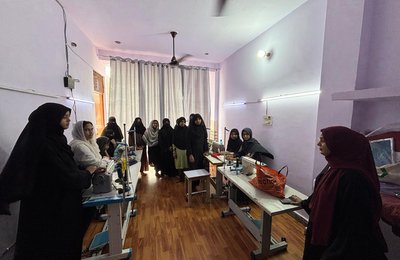Online and offline, COVID-19 still impacts local peacebuilding in Pakistan
In this article, our Pakistan local peacebuilding expert, Dr. Zahid Ahmed Shahab, discusses the ongoing impacts of the COVID-19 pandemic on Pakistani Peacebuilders and their gradual shift towards using digital technologies.

In previous contributions to Peace Insight, I talked about some of the challenges that peacebuilding organisations are facing in Pakistan. These include ongoing government restrictions that have limited the reach of local civil society and have led to significant funding difficulties.
In July 2020, I also focused on the immediate impact of COVID-19 on peace and conflict in Pakistan. As the pandemic continues to spread in Pakistan, with more contagious variants forcing the government to impose lockdowns in different cities, I felt it was time to revisit its impacts on peacebuilding in the country. For this article, I spoke to some of the country’s leading peacebuilders to understand the true extent of the crisis.
As of January 2022, there has been over 1.4 million positive cases in Pakistan, and over 29,000 COVID-related deaths. For a country of more than 207 million people with limited economic resources, the biggest challenge has been vaccinating the entire population. There is still a long way to go before a significant proportion of the population is vaccinated. This also means that the return to normality will take more time, disrupting peacebuilding at the grassroots level.
The pandemic’s immediate effects
The pandemic has negatively affected the livelihoods of millions, and it will take many years for people to recover, even when the situation normalises. Pakistan’s own government data mentions that 44% of the country’s population is vulnerable due to the pandemic. Moreover, vulnerability has increased for the 24.3% of the country living below the poverty line.
As the pandemic placed restrictions on people’s mobility, local peacebuilding organisations had to adjust to the ‘work from home’ option; a shift that proved difficult for many of the peacebuilders I spoke to. Shahid Rahim from Search for Common Ground explained that peacebuilding activities have essentially ground to a halt as access to conflict-affected areas is getting worse, and because government restrictions have limited their ability to organise gatherings and meetings. Rahim revealed that as a result, almost “99% of [peacebuilding] organisations are avoiding visiting these areas and are not allowed to conduct any activities”. Sadia Chaudhary of the Insan Foundation Trust further noted how the pandemic has affected people both economically and psychologically, adding, “The pandemic has had a really bad impact on the economic conditions of communities. It is very challenging to keep a high morale”.
Another local peacebuilder shared that her organisation, the Centre for Research and Security Studies (CRSS), had to stop their flagship project ‘Pakistan Center of Excellent’ that focusses on countering violent extremism. This was mainly because the project involved monthly workshops at university campuses around the country, which have been sporadically closed throughout he pandemic. A CRSS staff member shared: “As soon as universities opened, the activities restarted in September 2020 but were disrupted again due to the second wave and then the third wave of the pandemic”. Shagufta Khaliq, who works peacebuilding issues in Khyber Pakhtunkhwa (KP), had a similar experience. She shared the negative impacts of COVID-19 on her projects: “In KP our major intervention was halted due to the closure of universities. Similarly, the radio advocacy from the provincial radio suffered due to the restrictions on mobility and due to the SOPs regarding social distancing. The situation did not allow us to have guests in the studio for a live talk show.”
While it took time for some peacebuilding organisations to adapt to the new realities linked to the pandemic, they have gradually grown their ability to organise their activities virtually. As many were not aware of applications like Zoom in the beginning, they opted to use social media for their activities. An interviewee from CRSS shared that for their CVE project targeting university students they first created a closed Facebook group. For this, they emailed their partnering universities to obtain nominations of students who could be part of this Facebook group. Knowing about virtual technologies is one thing but the transformation virtual projects deliver is another. As Ms. Khaliq shared with reference to her capacity building projects, they had to redesign virtual sessions to include additional information on COVID-19. Her project linked to radio advocacy on countering violence was able to continue, as guests could join in by phone.
Peacebuilding for the people
Most of the peacebuilders interviewed for this article talked about the positive impacts that new technologies provided for their remote peacebuilding activities. Some also talked about a variety of challenges they faced using digital technologies in their peacebuilding work. Shahid Rahim said that such technologies might be common practice for nationally based NGO staff, but it is very difficult to expect remote communities to use the internet on their own. “Some things are challenging but people will get used to these technologies sooner or later. But, in Pakistan, where basic education and culture pose a challenge, this might take some more time”. Shagufta Khaliq shared that switching to Zoom, Google Meet and Microsoft Teams was the only means of connectivity and built users’ capacity both at the individual and organisational level. She did, however, talk about the limitations of carrying out peacebuilding activities virtually:
“Peacebuilding is by the people and for the people, we may say. It’s about human beings and their coexistence. Well, it's both ways, we can say that virtual technologies are effective in situations where there are no other options. However, since the audience engaged is mostly trained in physical interactions, and peacebuilding interventions aim at conceptual learning, soft skills development, cross-cultural interactions, dialogues, etc., the absence of these practical experiences reduce the effectiveness of peacebuilding initiatives."
Peacebuilders also shared the challenges they faced transitioning to online modes of operation. An Islamabad-based peacebuilder who preferred to remain anonymous revealed that, “We initially used Facebook as a medium to conduct live sessions but there were a lot of technical issues which were seemingly impossible to resolve”. She further said that their participants were not showing up to live sessions as much because they were more interested in face-to-face interactions with other participants and guest speakers. Ultimately the organisation had to move to Zoom with a limited audience to meet the project targets by conducting two workshops. She said these events were successful because Zoom was seen as more user-friendly for the participants. Similarly, Rahim talked about a variety of challenges associated with virtual peacebuilding, such as communities not having access to the internet and participants being less engaged, or not taking the initiative seriously. Sadia Chaudhary also talked about how her organisation has struggled to use Zoom to continue projects, as in many communities people do not have computers, or face a lack of internet and continual power shortages.
Not all organisations are new to digital technologies. Many, especially among youth-led organisations, were using the internet and social media to sustain their projects. Renaissance by Social Innovation, for example, always had both community-based and social media projects. During the pandemic, Sidra Rafique, the organisation’s co-founder, shared how they started using Zoom and Microsoft Teams to run dialogues and interviews and often recorded those proceedings and circulated them through Facebook.
Adapting to a new reality
Faced with very difficult circumstances, local peacebuilders in Pakistan have managed to adapt well to their new reality. This is reflected in their increasing use of social media and communication platforms to conduct virtual dialogue sessions and maintain their relationships with local communities.
As technologies can be very useful and cost effective, an obvious question is whether peacebuilding organisations will continue to use them when things return to normal. All interviewees agreed that digital technologies should be used more often after the pandemic wanes. Digital spaces can be used as an alternative to deliver peacebuilding programmes, but it should not replace in-person interactions because they provide opportunities to observe people’s body language as well as their interests and understanding of peacebuilding issues. Considering this, it is very likely that digital technologies will continue to be adopted by peacebuilding organisations, but their use will be limited for activities that require more in-person interactions for better outcomes.




